Transdermal Flunixin Meglumine as a Pain Relief in Donkeys: A Pharmacokinetics Pilot Study
Abstract
:1. Introduction
2. Materials and Methods
2.1. Animals and Housing
2.2. Study Design
2.3. Blood Collection and Analysis
2.4. Statistical Analysis
2.4.1. Flunixin and 5OH Flunixin Concentration Best Fitting Model Determination across Administration Routes
2.4.2. Flunixin and 5OH Flunixin Six Order Legendre Polynomial Curve Shape Parameters
2.4.3. Parametric Assumptions Testing and Approach Decision
2.4.4. Bayesian Paired t-Test to Detect Differences in the Mean across Administration Routes
2.4.5. Effect of the Flunixin Administration Route on Eicosanoids
3. Results
3.1. Bayesian Paired t-Test to Detect Differences in the Mean across Administration Routes
3.2. Different Pharmacokinetic Parameters following Oral, Intravenous, and Transdermal Administration of Flunixin Meglumine
3.3. Effect of the Flunixin Administration Route on Eicosanoids
4. Discussion
5. Study Limitations
6. Conclusions
Supplementary Materials
Author Contributions
Funding
Institutional Review Board Statement
Informed Consent Statement
Data Availability Statement
Acknowledgments
Conflicts of Interest
References
- Matthews, N.; van Loon, J.P.A.M. Anesthesia and analgesia of the donkey and the mule. Equine Vet. Educ. 2013, 25, 47–51. [Google Scholar] [CrossRef]
- Weissmann, G.; Korchak, H.; Ludewig, R.; Edelson, H.; Haines, K.; Levin, R.I.; Herman, R.; Rider, L.; Kimmel, S.; Abramson, S. Non-steroidal anti-inflammatory drugs: How do they work? Eur. J. Rheumatol. Inflamm. 1987, 8, 6–17. [Google Scholar] [PubMed]
- Ciofalo, V.B.; Latranyi, M.B.; Patel, J.B.; Taber, R.I. Flunixin meglumine: A non-narcotic analgesic. J. Pharmacol. Exp. Ther. 1977, 200, 501–507. [Google Scholar] [PubMed]
- Lees, P.; Higgins, A.J. Clinical pharmacology, and therapeutic uses of non-steroidal anti-inflammatory drugs in the horse. Equine Vet. J. 1985, 17, 83–96. [Google Scholar] [CrossRef]
- Jackman, B.R.; Moore, J.N.; Barton, M.H.; Morris, D.D. Comparison of the effects of ketoprofen and flunixin meglumine on the in vitro response of equine peripheral blood monocytes to bacterial endotoxin. Can. J. Vet. Res. 1994, 58, 138–143. [Google Scholar] [PubMed]
- Cheng, Z.; McKellar, Q.; Nolan, A.; Lees, P. Preliminary pharmacokinetic and pharmacodynamic studies on flunixin meglumine in donkeys. Vet. Res. Commun 1996, 20, 469–472. [Google Scholar] [CrossRef]
- FDA (U.S. Food and Drug Administration CFR)-Code of Federal Regulations Title 21. Available online: https://www.accessdata.fda.gov/scripts/cdrh/cfdocs/cfcfr/CFRSearch.cfm?fr=522.970 (accessed on 4 June 2023).
- Knych, H.K.; Arthur, R.M.; McKemie, D.S.; Baden, R.W.; Seminoff, K.; Kass, P.H. Pharmacokinetics and anti-inflammatory effects of flunixin meglumine as a sole agent and in combination with phenylbutazone in exercised Thoroughbred horses. Equine Vet. J. 2020, 53, 102–116. [Google Scholar] [CrossRef]
- Hardee, G.E.; Smith, J.A.; Harris, S.J. Pharmacokinetics of flunixin meglumine in the cow. Res. Vet. Sci. 1985, 39, 110–112. [Google Scholar] [CrossRef]
- Lizarrage, I.; Sumano, H.; Brumbaugh, G.W. Pharmacological and pharmacokinetic differences between donkeys and horses. Equine Vet. Educ. 2004, 16, 102–112. [Google Scholar] [CrossRef]
- Clark, J.O.; Clark, T.P. Veterinary Clinics of North America: Equine Practice. Analgesia 1999, 15, 705–723. [Google Scholar]
- Bruehaus, B.A.; Brown, C.M.; Scott, E.A.; Ainsworth, D.M.; Taylor, R.F. Clostridial muscle infections following intramuscular injections in the horse. J. Equine Vet. Sci. 1983, 3, 42–46. [Google Scholar] [CrossRef]
- Knych, H.K.; Arthur, R.M.; Gretler, S.R.; McKemie, D.S.; Goldin, S.; Kass, P.H. Pharmacokinetics of transdermal flunixin meglumine and effects on biomarkers of inflammation in horses. J. Vet. Pharmacol. Ther. 2021, 44, 745–753. [Google Scholar] [CrossRef]
- Kleinhenz, M.D.; Van Engen, N.K.; Gorden, P.J.; KuKanich, B.; Rajewski, S.M.; Walsh, P.; Coetzee, J.F. The pharmacokinetics of transdermal flunixin meglumine in Holstein calves. J. Vet. Pharmacol. Ther. 2016, 39, 612–615. [Google Scholar] [CrossRef]
- Reppert, E.J.; Kleinhenz, M.D.; Montgomery, S.R.; Bornheim, H.N.; Magnin, G.; Sidhu, P.K.; Zhang, Y.; Joo, H.; Coetzee, J.F. Pharmacokinetics and pharmacodynamics of intravenous and transdermal flunixin meglumine in meat goats. J. Vet. Pharmacol. Ther. 2019, 42, 309–317. [Google Scholar] [CrossRef]
- Kittrell, H.C.; Mochel, J.P.; Brown, J.T.; Forseth, A.M.K.; Hayman, K.P.; Rajewski, S.M.; Coetzee, J.F.; Schneider, B.K.; Ratliffe, B.; Skoland, K.J.; et al. Pharmacokinetics of Intravenous, Intramuscular, Oral, and Transdermal Administration of Flunixin Meglumine in Pre-wean Piglets. Front. Vet. Sci. 2020, 7, 586. [Google Scholar] [CrossRef]
- Merck Animal Health Banamine® Transdermal. 2023. Available online: https://www.merck-animal-health-usa.com/species/cattle/products/banamine-transdermal/how-to-use (accessed on 6 June 2023).
- Pietruk, M.; Jedziniak, P.; Olejnik, M. LC-MS/MS Determination of 21 Non-Steroidal Anti-Inflammatory Drugs Residues in Animal Milk and Muscles. Molecules 2021, 26, 5892. [Google Scholar] [CrossRef]
- Depaoli, S.; Van de Schoot, R. Improving transparency and replication in Bayesian statistics: The WAMBS-Checklist. Psychol. Methods 2017, 22, 240. [Google Scholar] [CrossRef]
- Schalken, N.; Behrens, L.; Smeets, L.; van de Schoot, R. First Bayesian Inference: SPSS (t-Test). Available online: https://www.rensvandeschoot.com/tutorials/bayesian-regression-spss/ (accessed on 1 May 2022).
- Jeffreys, H. Theory of Probability, 3rd ed.; Oxford University Press: Oxford, UK, 1961. [Google Scholar]
- Lee, M.D.; Wagenmakers, E.-J. Bayesian Data Analysis for Cognitive Science: A Practical Course. 2013. Available online: File:///C:/Users/Essam/Downloads/LeeWagenmakers2013.pdf (accessed on 5 April 2023).
- Orth, E.K.; Navas González, F.J.; Iglesias Pastrana, C.; Berger, J.M.; Jeune, S.S.l.; Davis, E.W.; McLean, A.K. Development of a Donkey Grimace Scale to Recognize Pain in Donkeys (Equus asinus) Post Castration. Animals 2020, 10, 1411. [Google Scholar] [CrossRef]
- Pritchard, J.C.; Lindberg, A.C.; Main, D.C.J.; Whay, H.R. Assessment of the welfare of working horses, mules, and donkeys, using health and behaviour parameters. Prev. Vet. Med. 2005, 69, 265–283. [Google Scholar] [CrossRef]
- Grosenbaugh, D.A.; Reinemeyer, C.R.; Figueiredo, M.D. Pharmacology and therapeutics in donkeys. Equine Vet. Educ. 2011, 23, 523–530. [Google Scholar] [CrossRef]
- Coakley, M.; E Peck, K.; Taylor, T.S.; Matthews, N.S.; Mealey, K.L. Pharmacokinetics of flunixin meglumine in donkeys, mules, and horses. Am. J. Vet. Med. Res. 1999, 60, 1441–1444. [Google Scholar]
- Hassan, F.; Altaf, S.; Ijaz, M.; Tahir, M. A review on flunixin meglumine. Int. J. Med. 2016, 1, 136–138. [Google Scholar]
- Cramer, M.C.; Pairis-Garcia, M.D.; Bowman, A.S.; Moeller, S.J.; Zhang, Y.; Sidhu, P.K.; Magnin, G.; Coetzee, J.F. Pharmacokinetics of transdermal flunixin in sows. J. Vet. Pharmacol. Ther. 2019, 42, 492–495. [Google Scholar] [CrossRef] [PubMed]
- Lees, P.; Ewins, C.P.; Taylor, B.O.; Sedgwick, A.D. Serum thromboxane in the horse and its inhibition by aspirin, phenylbutaaone and fhmixin. Br. Vet. J. 1987, 143, 462–476. [Google Scholar] [CrossRef]
- McKellar, Q.A.; Galbraith, E.A.; Bogan, J.A.; Russell, C.S.; Hooke, R.E.; Lees, P. Flunixin pharmacokinetics and serum thromboxane inhibition in the dog. Vet. Rec. 1989, 124, 651–654. [Google Scholar] [CrossRef]
- Landoni, M.F.; Lees, P. Comparison of the anti-inflammatory actions of flunixin and ketoprofen in horses applying PK/PD modeling. Equine Vet. J. 1995, 27, 247–256. [Google Scholar] [CrossRef]
- Grint, N.J.; Murrell, J.C.; Whay, H.R. Investigating the opinions of donkey owners and veterinary surgeons towards pain and analgesia in donkeys. Equine Vet. J. 2015, 27, 365–371. [Google Scholar] [CrossRef]

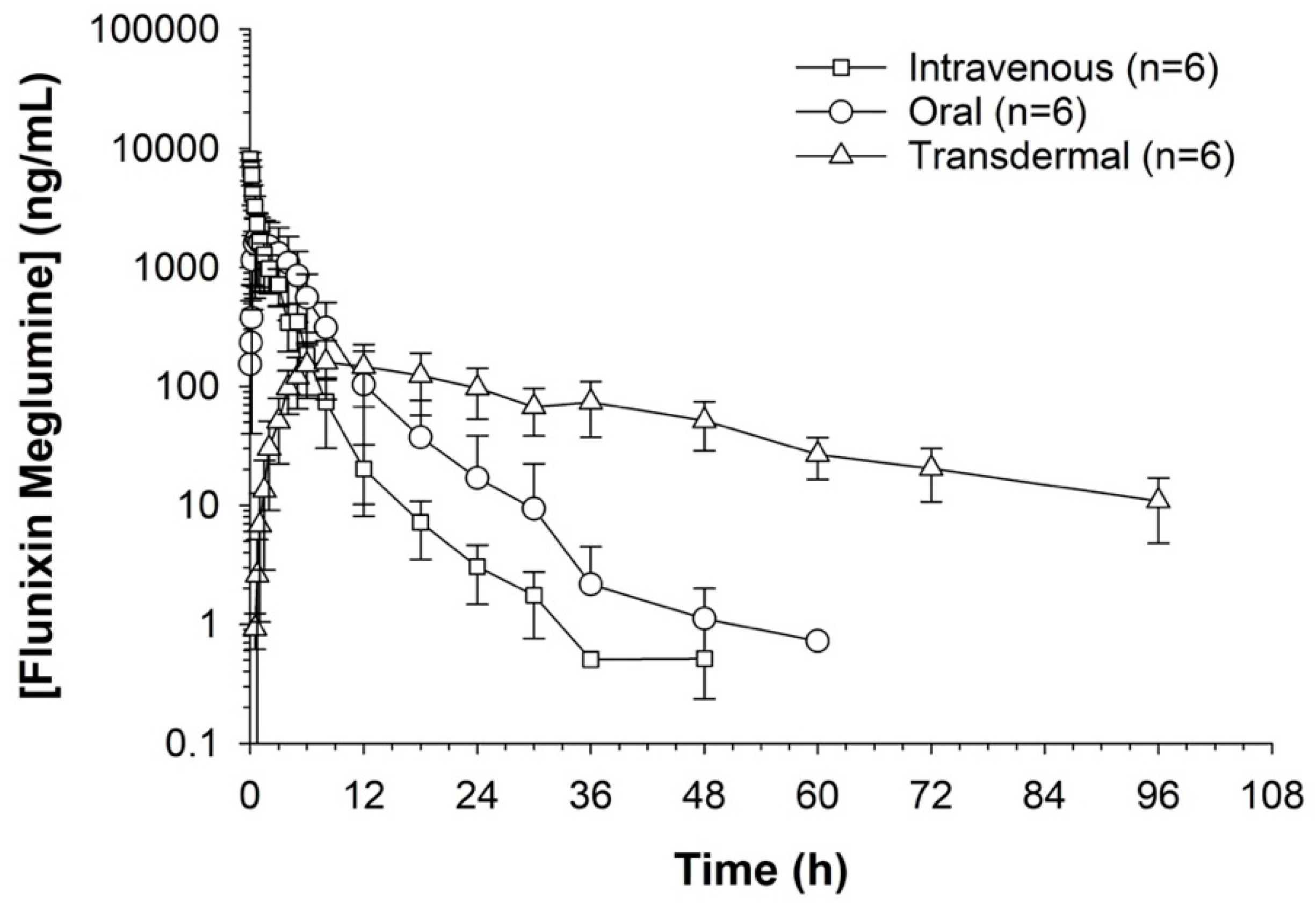
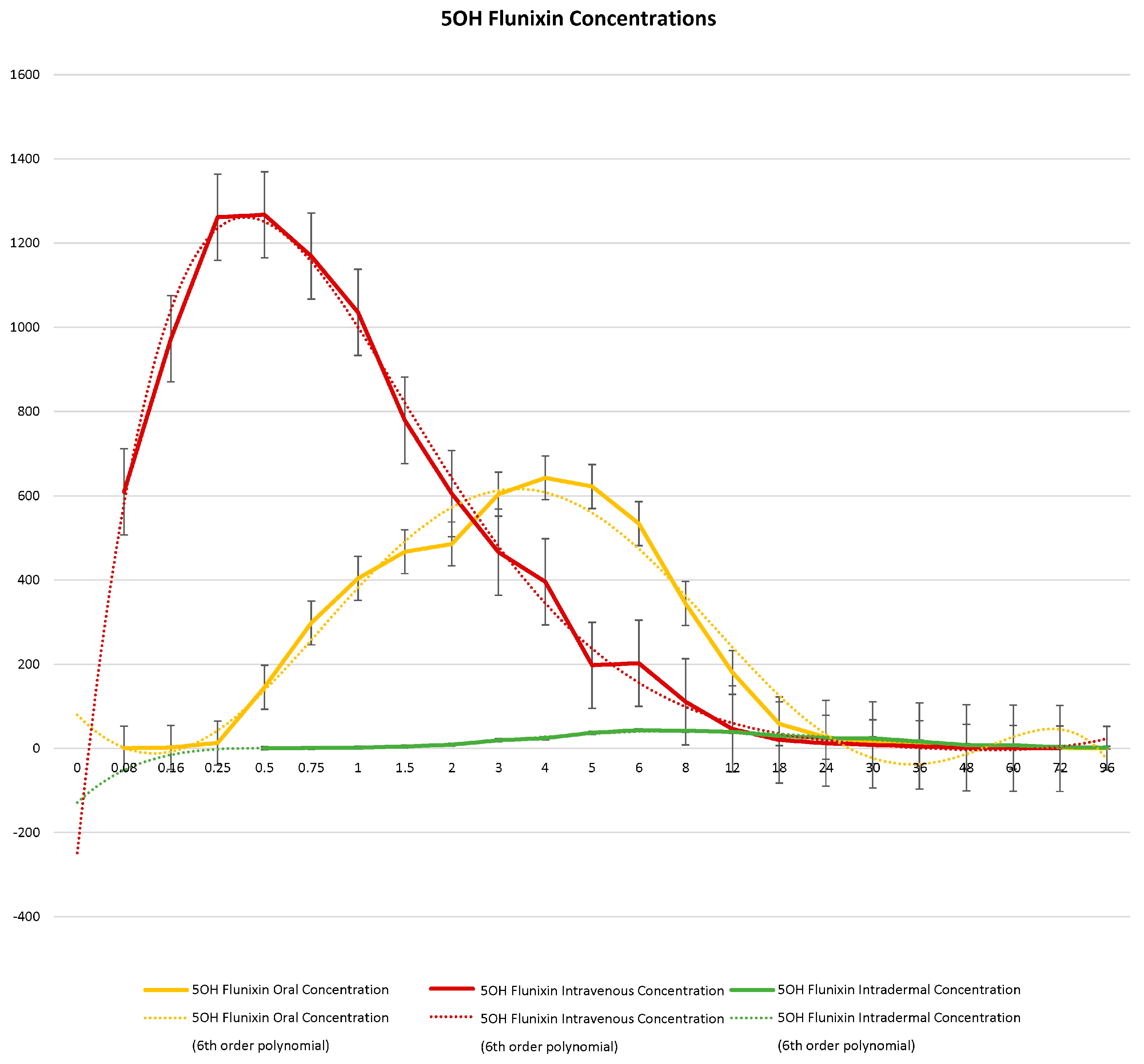

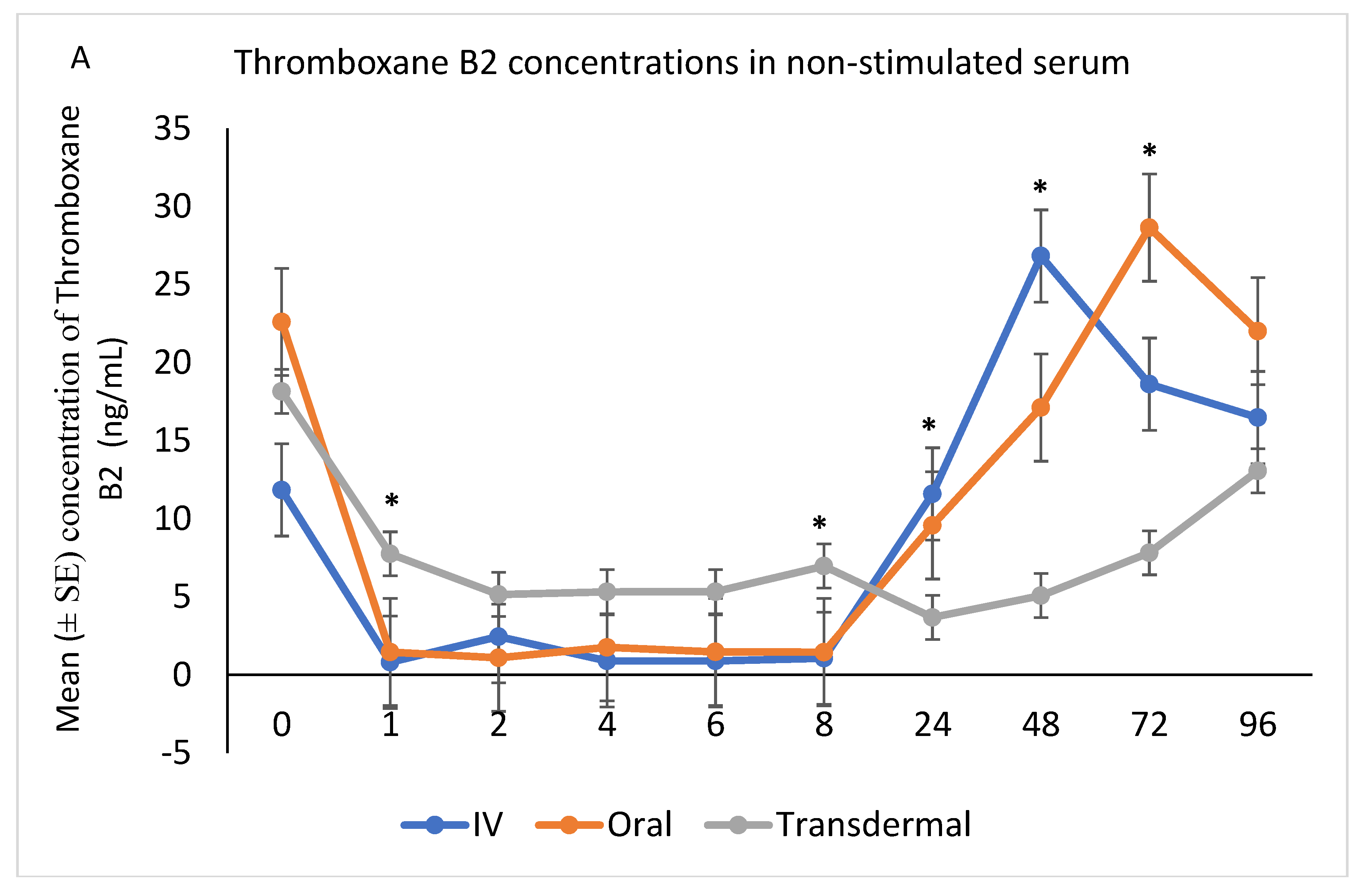

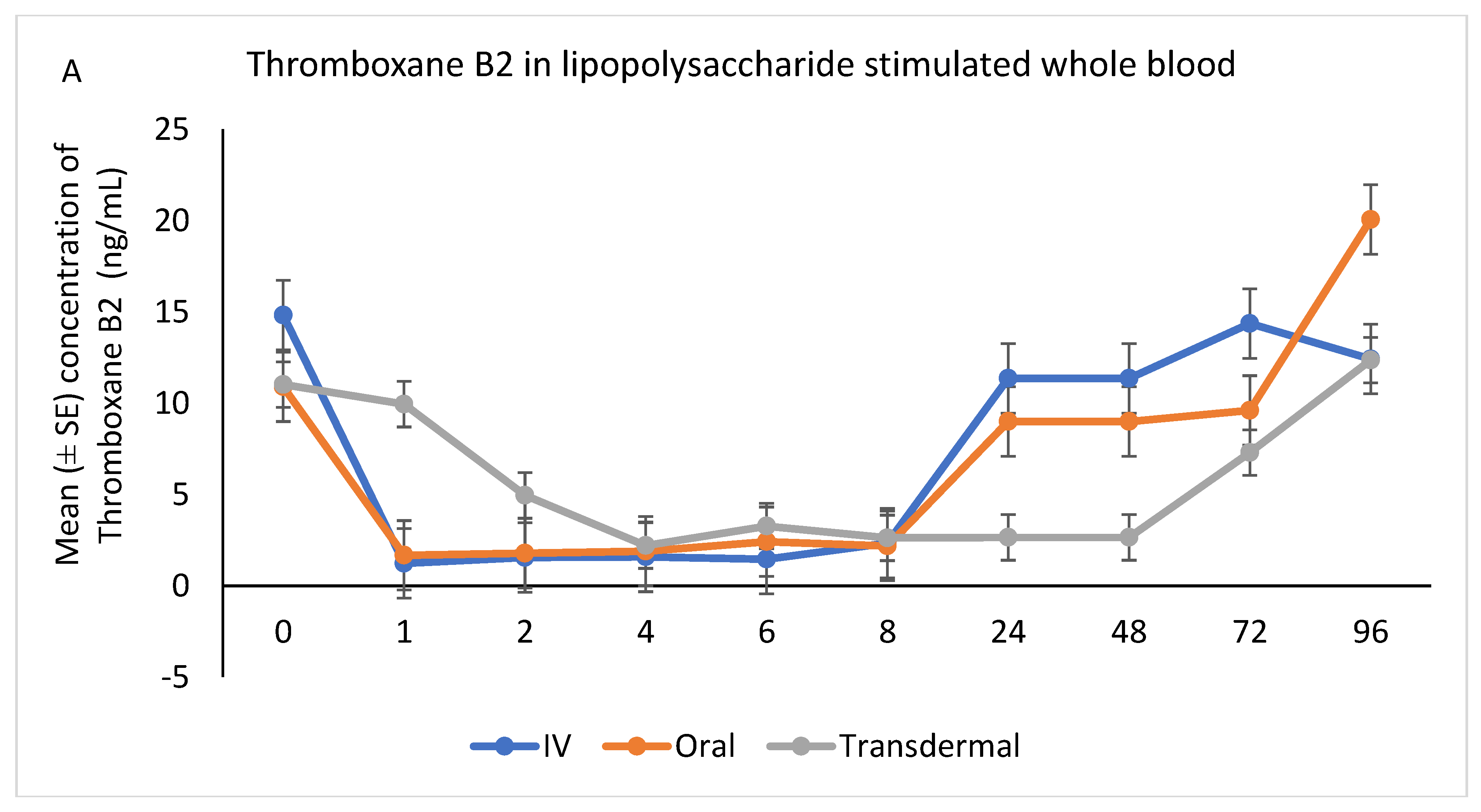
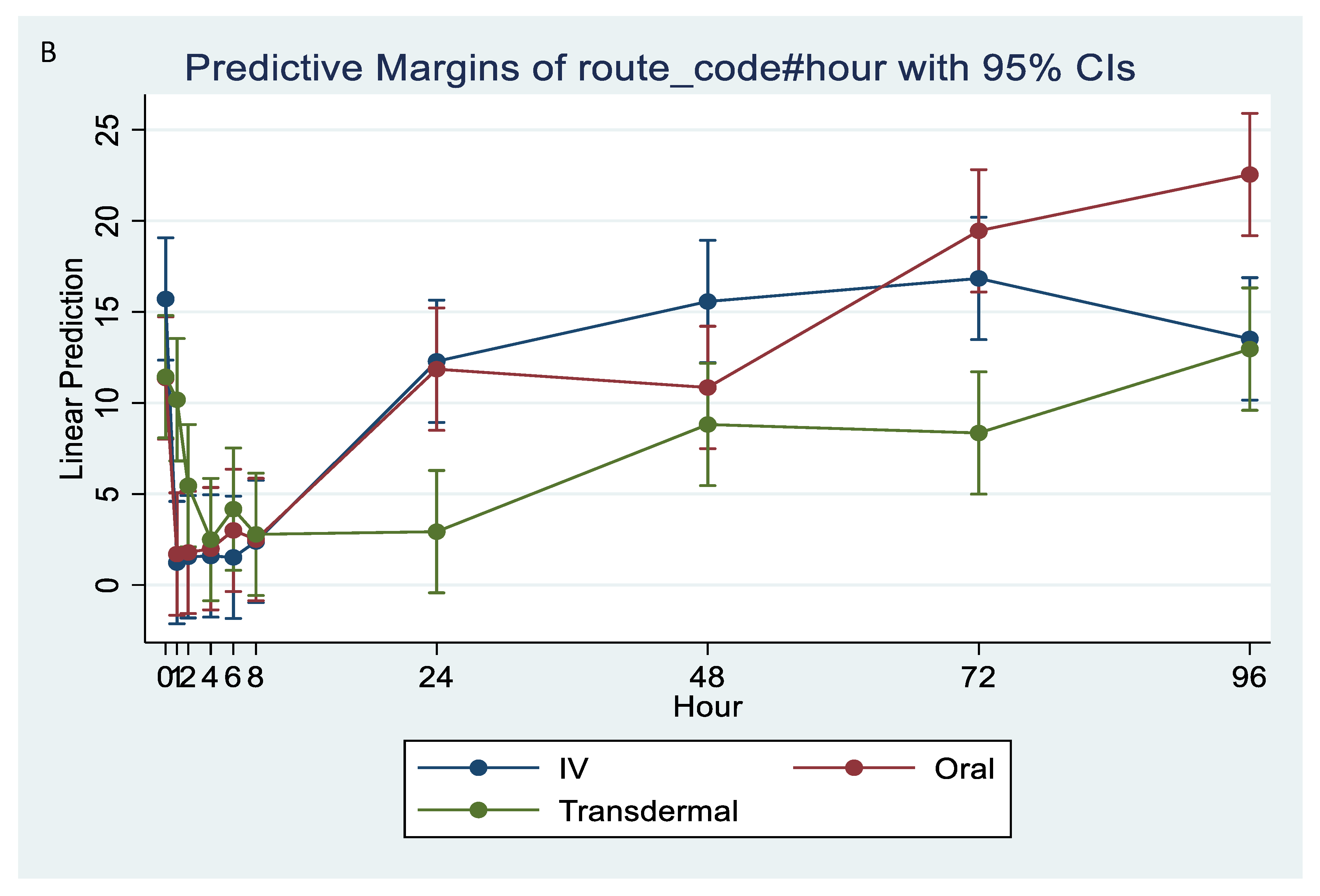

| Route of Flunixin Administration | Values 1 | AUC/Dose | Cmax | tmax | Drug Half-Life (t1/2) | AUCINF | AUClast |
|---|---|---|---|---|---|---|---|
| Units | mg | ng/mL | h | 1/h | h × ng/mL | h × ng/mL | |
| IV | Mean ± SE | 1.23 ± 0.02 c | 9839.42 ± 452.12 a | 0.08 ± 0.00 c | 0.13 ± 0.004 a | 10,641.68 ± 1096.733 a | 10,632.23 ± 1094.69 a |
| Median | 1.2 | 9712.673 | 0.08 | 0.137 | 9845.625 | 9838.74 | |
| 95% Conf. Interval | 1.18–1.27 | 8885.51–10,793.33 | 0.126– 0.145 | 8327.778–12,955.58 | 8322.62–12,941.83 | ||
| PO | Mean ± SE | 2.75 ± 0.05 b | 1976.8 ± 463.63 b | 1.33 ± 0.35 b | 0.13 ± 0.013 a | 12,589.17 ± 3145.094 a | 12,583.5–3144.97 a |
| Median | 2.7 | 2146.45 | 1 | 0.136 | 11,817.5 | 11,812.5 | |
| 95% Conf. Interval | 2.63–2.86 | 998.61–2954.98 | 0.59–2.07 | 0.106–0.164 | 5953.599–19,224.73 | 5948.18–19,218.82 | |
| TD | Mean ± SE | 4.38 ± 0.01 a | 161.46 ± 33.89 c | 5.83 ± 0.16 a | 0.04 ± 0.002 b | 4521 ± 787.34 b | 4383.66–757.05 b |
| Median | 4.4 | 171.30 | 6 | 0.039 | 5194 | 5043 | |
| 95% Conf. Interval | 4.34–4.42 | 89.96–232.97 | 5.48–6.18 | 0.036–0.045 | 2859.843–6182.157 | 2786.42–5980.91 | |
| p-value | <0.001 | <0.001 | 0.001 | <0.001 | 0.014 | 0.013 |
Disclaimer/Publisher’s Note: The statements, opinions and data contained in all publications are solely those of the individual author(s) and contributor(s) and not of MDPI and/or the editor(s). MDPI and/or the editor(s) disclaim responsibility for any injury to people or property resulting from any ideas, methods, instructions or products referred to in the content. |
© 2023 by the authors. Licensee MDPI, Basel, Switzerland. This article is an open access article distributed under the terms and conditions of the Creative Commons Attribution (CC BY) license (https://creativecommons.org/licenses/by/4.0/).
Share and Cite
McLean, A.K.; Falt, T.; Abdelfattah, E.M.; Middlebrooks, B.; Gretler, S.; Spier, S.; Turoff, D.; Navas Gonzalez, F.J.; Knych, H.K. Transdermal Flunixin Meglumine as a Pain Relief in Donkeys: A Pharmacokinetics Pilot Study. Metabolites 2023, 13, 776. https://doi.org/10.3390/metabo13070776
McLean AK, Falt T, Abdelfattah EM, Middlebrooks B, Gretler S, Spier S, Turoff D, Navas Gonzalez FJ, Knych HK. Transdermal Flunixin Meglumine as a Pain Relief in Donkeys: A Pharmacokinetics Pilot Study. Metabolites. 2023; 13(7):776. https://doi.org/10.3390/metabo13070776
Chicago/Turabian StyleMcLean, Amy K., Tara Falt, Essam M. Abdelfattah, Brittany Middlebrooks, Sophie Gretler, Sharon Spier, David Turoff, Francisco Javier Navas Gonzalez, and Heather K. Knych. 2023. "Transdermal Flunixin Meglumine as a Pain Relief in Donkeys: A Pharmacokinetics Pilot Study" Metabolites 13, no. 7: 776. https://doi.org/10.3390/metabo13070776
APA StyleMcLean, A. K., Falt, T., Abdelfattah, E. M., Middlebrooks, B., Gretler, S., Spier, S., Turoff, D., Navas Gonzalez, F. J., & Knych, H. K. (2023). Transdermal Flunixin Meglumine as a Pain Relief in Donkeys: A Pharmacokinetics Pilot Study. Metabolites, 13(7), 776. https://doi.org/10.3390/metabo13070776







